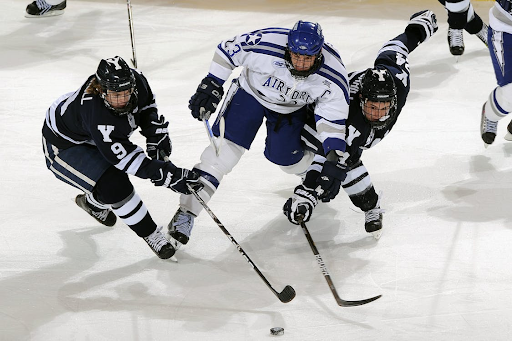
|
Ice hockey is played on an ice rink, and you can bet on it on IviBet login. Each team consists of six players (five outfield players and a goalkeeper) who are equipped with ice skates. The objective is to score goals by sending a vulcanized rubber disk called puck or round, into the opposing net, placed at the other end of the ice rink. Players handle the puck using a hockey stick also called a hockey stick.
The five outfield players are usually three attackers (a centre, a left winger and a right winger) and two defenders. A group of three attackers form an attack line and a pair of defenders form a defense line. There are also lines specific to situations of numerical inferiority or numerical superiority.
Line changes can occur during stoppages of play, but also during the game (we then speak of a flying change).
A hockey team has about twenty players (four lines of attackers, three or four of defenders and two goalkeepers).
Certain charges and contacts are allowed on the disc carrier. It is, above all, to hinder the opponent, to destabilize him during next contacts, to tire him and to make him lose the puck. It is a basic technique in hockey. We then speak of failure.
The band (or railing) around the ice helps keep the puck inside the rink, so play can last for several minutes without interruption. When the action stops, play always resumes with a face-off (or face-off). The two major rules limiting puck movement are offside and icing.
A match lasts three periods of 20 minutes each, the clock being stopped at each stoppage of play. In the event of a tie at the end of regulation time, the procedure varies according to the context and according to the rules specific to each championship. The match can then continue with a sudden-death overtime period to determine a winner. If the score is unchanged at the end of overtime, a shootout may proceed.
A match may also include fights between players, fights tolerated or prohibited depending on the leagues and competitions.
The origins of hockey
If there is one paternity that is disputed to say the least, it is that of the invention of hockey. Jumbled up, the Canadians, the Americans, the Scots, the Irish, the Dutch, the Amerindians, and even the French, have found in their traditional games a more or less convincing ancestor of hockey.
It is true that lacrosse games were played in Europe during the Middle Ages: English shinney (and its Scottish ancestor, shinty), hurling (or hurley) in Ireland, lacrosse soule in France and ken jaegen in the Netherlands, more precisely in Friesland. Allusions to such games generally date back to the fifteenth or even the fourteenth century. Note however that most of these sports were not practiced (or not exclusively) on ice, and can very well also be considered as the ancestor of other sports, such as field hockey, just as soule is both the ancestor of football, rugby, handball, etc. The “specificity” of a sport generally comes from its first clearly established rules, we will come back to this.







